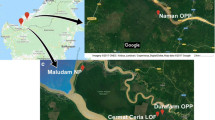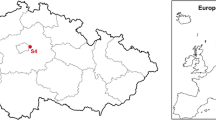Abstract
We surveyed the diversity of cultivable fungi isolated from cold and hot volcanic soils of Deception Island, Antarctica. Seventy-four fungal isolates were identified; these belonged to 17 taxa in the genera Aspergillus, Penicillium, Pseudogymnoascus, Purpureocillium, and Mortierella. The fungal assemblages showed low diversity, richness, and dominance indices. The Aspergillus taxa were dominant in the soils at 0 °C, 50 °C, and 100 °C. Aspergillus lacticoffeatus, Aspergillus cf. ruber, Penicillium citrinun, and Purpureocillium sodanum were present only in soils having a temperature of 100 °C. Aspergillus calidoustus was present in all thermal soils and displayed the highest densities. The majority of fungi displayed mesophilic behavior; however, different isolates of Aspergillus lacticoffeatus and Aspergillus niger were able to grow at 50 °C; these are phylogenetically close to the causative agents of aspergillosis in immunocompromised individuals. Deception Island perhaps represents one of the most visited regions in Antarctica and the tourism there has increased over the last 20 years, especially by elderly tourists, probably with weak immune systems, come in contact with the resident microorganisms, including the thermo-resistant opportunistic Aspergillus species.
Similar content being viewed by others
References
Altschul SF, Madden TL, Schaffer AA, Zhang JH, Zhang Z, Miller W, Lipman DJ (1997) Gapped BLAST and PSI-BLAST: a new generation of protein database search programs. Nucleic Acids Res 25:3389–3402
Arenz BE, Blanchette RA (2011) Distribution and abundance of soil fungi in Antarctica at sites on the Peninsula, Ross Sea Region and McMurdo Dry Valleys. Soil Biol Biochem 43:308–315
Azmi OR, Seppelt RD (1998) Fungi of the Windmill Islands, continental Antarctica. Effect of temperature, pH and culture media on the growth of selected microfungi. Polar Biol 18:128–134
Bardou P, Mariette J, Escudié F et al (2014) An interactive Venn diagram viewer. BMC Bioinformatics 15:293
Blöchl E, Rachel R, Burggraf S, Hafenbradl D, Jannasch HW, Stetter KO (1997) Pyrolobus fumarii, gen. and sp. nov., represents a novel group of archaea, extending the upper temperature limit for life to 113°C. Extremophiles 1:14–21
Bridge PD, Newsham KK (2009) Soil fungal community composition at Mars Oasis, a southern maritime Antarctic site, assessed by PCR amplification and cloning. Fungal Ecol 2:66–74
Brock TD (1995) The road to Yellowstone and beyond. Annu Rev Microbiol 49:1–28
Cooney DG, Emerson R (1964) Thermophilic fungi: an account of their biology, activities and classification. W.H. Freeman & Co., San Francisco
Crisan EV (1973) Current concepts of thermophilism and the thermophilic fungi. Mycologia 65:1171–1198
Ellis DH (1980) Thermophilic fungi isolated from a heated aquatic habitat. Mycologia 72:1030–1033
Fell JW, Scorzetti G, Connell L, Craig S (2006) Biodiversity of micro-eukaryotes in Antarctic Dry Valley soils with %3c 5% soil moisture. Soil Biol Biochem 38:3107–3119
Furbino LE, Godinho VM, Santiago IF et al (2014) Diversity patterns, ecology and biological activities of fungal communities associated with the endemic macroalgae across the Antarctic. Microbial Ecol 67:775–787
Gautier M, Normand AC, Ranque S (2016) Previously unknown species of Aspergillus. Clin Microbiol Infect 22:662–669
Glass NL, Donaldson GC (1995) Development of primer sets designed for use with the PCR to amplify conserved genes from filamentous ascomycetes. Appl Environ Microbiol 61:1323–1330
Godinho VM, Furbino LE, Santiago IF et al (2013) Diversity and bioprospecting of fungal communities associated with endemic and cold-adapted macroalgae in Antarctica. ISME J 7:1434–1451
Godinho VM, Gonçalves VN, Santiago IF, Figueredo HM, Vitoreli GA, Schaefer CEGR et al (2015) Diversity and bioprospection of fungal community present in oligotrophic soil of continental Antarctica. Extremophiles 19:585–596
Gomes EC, Godinho VM, Silva DA et al (2018) Cultivable fungi present in Antarctic soils: taxonomy, phylogeny, diversity, and bioprospecting of antiparasitic and herbicidal metabolites. Extremophiles 22:381–393
Gonçalves VN, Vaz ABM, Rosa CA et al (2012) Diversity and distribution of fungal communities in lakes of Antarctica. FEMS Microbiol Ecol 82:459–471
Gonçalves VN, Carvalho CR, Susana Johann S et al (2015) Antibacterial, antifungal and antiprotozoal activities of fungal communities present in different substrates from Antarctica. Polar Biol 38:1143–1152
Hammer Ø, Harper DAT, Ryan PD (2001) PAST: paleontological statistics software package for education and data analysis. Paleont Electron 4:1–9
Houbraken J, Frisvad JC, Seifert KA, Overy DP, Tuthill DM, Valdez JG, Samson RA (2012) New penicillin-producing Penicillium species and an overview of section Chrysogena. Persoonia 29:78–100
Houbraken J, de Vries RP, Samson RA (2014) Modern taxonomy of biotechnologically important Aspergillus and Penicillium species. In: San AAM (ed) Sariaslani S, Gadd GM. Academic Press, Diego, pp 199–249
Jesenská Z, Piecková E, Bernát D (1993) Heat resistance of fungi from soil. Int J Food Microbiol 19:187–192
Kane BE, Mullins JT (1973) Thermophilic fungi in a municipal waste compost system. Mycologia 65:1087–1100
Kirk PM, Cannon PF, Minter DW, Stalpers JA (2008) Dictionary of the fungi, 10th edn. Wallingford, UK, CAB International
Kumar S, Stecher G, Li M, Knyaz C, Tamura K (2018) MEGA X: molecular evolutionary genetics analysis across computing platforms. Mol Biol Evol 35:1547–1549
Loque CP, Medeiros AO, Pellizzari FM, Oliveira EC, Rosa CA, Rosa LH (2010) Fungal community associated with marine macroalgae from Antarctica. Polar Biol 33:641–648
Madariaga-Mazón A, González-Andrade M, González MC, Glenn AE, Cerda-García-Rojas CM, Mata R (2013) Absolute configuration of acremoxanthone C, a potent calmodulin inhibitor from Purpureocillium lilacinum. J Nat Prod 76:1454–1460
Maheshwari R, Bharadwaj G, Bhat MK (2000) Thermophilic fungi: their physiology and enzymes. Microbiol Mol Biol Rev 64:461–488
Munoz PA, Flores PA, Boehmwald FA, Blamey JM (2011) Thermophilic bacteria present in a sample from Fumarole Bay, Deception Island. Antarct Sci 23:549–555
Oliveira TB, Gomes E, Rodrigues A (2015) Thermophilic fungi in the new age of fungal taxonomy. Extremophiles 19:31–37
Pan WZ, Huang XW, Wei KB, Zhang CM, Yang DM, Ding JM, Zhang KG (2010) Diversity of thermophilic fungi in Tengchong Rehai National Park revealed by ITS nucleotide sequence analy-ses. J Microbiol 48:146–152
Person AK, Chudgar SM, Norton BL, Tong BC, Stout JE (2010) Aspergillus niger: an unusual cause of invasive pulmonary aspergillosis. J Med Microbiol 59:834–838
Powell AJ, Parchert KJ, Bustamante JM, Ricken JB, Hutchinson MI, Natvig DO (2012) Thermophilic fungi in an aridland ecosystem. Mycologia 104:813–825
Rosa LH, Vaz ABM, Caligiorne RB, Campolina S, Rosa CA (2009) Endophytic fungi associated with the Antarctic Grass Deschampsia antarctica Desv. (Poaceae). Polar Biol 32:161–167
Rosa LH, Vieira MLA, Santiago IF et al (2010) Endophytic fungi community associated with the dicotyledonous plant Colobanthus quitensis (Kunth) Bartl. (Caryophyllaceae) in Antarctica. FEMS Microbiol Ecol 73:178–189
Rosa LH, Zani CL, Cantrell CL, Duke SO, Van Dijck P, Desideri A, Rosa CA (2019) Fungi in Antarctica: diversity, ecology, effects of climate change, and bioprospection for bioactive compounds. In: Rosa LH (ed) Fungi of Antarctica: diversity, ecology and biotechnological applications. Springer International Publishing, Switzerland, pp 10–17
Ruisi S, Barreca D, Selbmann L, Zucconi L, Onofri S (2007) Fungi in Antarctica. Rev Environm Sci Biotechnol 6:127–141
Samson RA, Houbraken JAMP, Kuijpers AFA, Frank JM, Frisvad JC (2004) New ochratoxin A or sclerotium producing species in Aspergillus section Nigri. Stud Mycol 50:45–61
Santiago IF, Soares MA, Rosa CA et al (2015) Lichensphere: a protected natural microhabitat of the non-lichenised fungal communities living in extreme environments of Antarctica. Extremophiles 19:1087–1097
Seroy J, Antiporta P, Grim SA, Proia LA, Singh K, Clark NM (2017) Aspergillus calidoustus case series and review of the literature. Transpl Infect Dis 19:e12755
Straatsma G, Samson RA, Olijnsma TW, Camp HJM, Gerrits JPG, Griensven LJLD (1994) Ecology of thermophilic fungi in mush-room compost, with emphasis on Scytalidium thermophilum and growth stimulation of Agaricus bisporus mycelium. Appl Environ Microbiol 60:454–458
Tosi S, Casado B, Gerdol R (2002) Fungi isolated From Antarctic mosses. Polar Biol 25:262–268
Tsang CC, Tang J, Lau S, Woo P (2018) Taxonomy and evolution of Aspergillus, Penicillium and Talaromyces in the omics era—past, present and future. Comput Struct Biotechnol J 16:197–210
Varga J, Houbraken J, Van Der Lee HA, Verweij PE, Samson RA (2008) Aspergillus calidoustus sp. nov., causative agent of human infections previously assigned to Aspergillus ustus. Eukaryot Cell 7:630–638
White TJ, Bruns TD, Lee SB (1990) Amplification and direct sequencing of fungal ribosomal RNA genes for phylogenetics. In: Innis NA, Gelfand J, Sninsky J, et al. (eds) PCR protocols: a guide to methods and applications. Academic Press, San Diego, pp 315–322
Zucconi L, Selbmann L, Buzzini P, Turchetti B, Guglielmin M, Frisvad JC, Onofri S (2012) Searching for eukaryotic life preserved in Antarctic permafrost. Polar Biol 35:749–757
Acknowledgements
We acknowledge the financial support from CNPq PROANTAR 442258/2018-6, INCT Criosfera II, CAPES (88887.136384/2017-00 and 88887.314457/2019-00), CNPq, FAPEMIG, and FNDCT.
Author information
Authors and Affiliations
Corresponding author
Additional information
Communicated by L. Huang.
Publisher's Note
Springer Nature remains neutral with regard to jurisdictional claims in published maps and institutional affiliations.
Electronic supplementary material
Below is the link to the electronic supplementary material.
Rights and permissions
About this article
Cite this article
Figueredo, H.M., Gonçalves, V.N., Godinho, V.M. et al. Diversity and ecology of cultivable fungi isolated from the thermal soil gradients in Deception Island, Antarctica. Extremophiles 24, 219–225 (2020). https://doi.org/10.1007/s00792-019-01146-z
Received:
Accepted:
Published:
Issue Date:
DOI: https://doi.org/10.1007/s00792-019-01146-z




